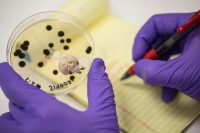As the operations manager at Los Sueños Farms, the largest outdoor cannabis farm in the country, I was tasked with the challenge of finding a yeast and mold remediation treatment method that would ensure safe and healthy cannabis for all of our customers while complying with stringent regulations.
While outdoor cannabis is not inherently moldy, outdoor farms are vulnerable to changing weather conditions. Wind transports spores, which can cause mold. Each spore is a colony forming unit if plated at a lab, even if not germinated in the final product. In other words, perfectly good cannabis can easily fail microbial testing with the presence of benign spores.
Fun Fact: one square centimeter of mold can produce over 2,065,000,000 spores.
If all of those landed on cannabis it would be enough to cause over 450 pounds of cannabis to fail testing, even if those spores remained ungerminated.

It should also be known that almost every food item purchased in a store goes through some type of remediation method to be considered safe for sale. Cannabis is finally becoming a legitimized industry and we will see regulations that make cannabis production look more like food production each year.
Regulations in Colorado (as well as Nevada and Canada) require cannabis to have a total yeast and mold count (TYMC) of ≤ 10,000 colony forming units per gram. We needed a TYMC treatment method that was safe, reliable, efficient and suitable for a large-scale operation. Our main problem was the presence of fungal spores, not living, growing mold.
Below is a short list of the pros and cons of each treatment method I compiled after two years of research:
Autoclave: This is the same technology used to sterilize tattoo needles and medical equipment. Autoclave uses heat and pressure to kill living things. While extremely effective, readily available and fiscally reasonable, this method is time-consuming and cannot treat large batches. It also utilizes moisture, which increases mold risk. The final product may experience decarboxylation and a change in color, taste and smell.
Dry Heat: Placing cannabis in dry heat is a very inexpensive method that is effective at reducing mold and yeast. However, it totally ruins product unless you plan to extract it.

Image: Tom Beatty, Flickr
Gamma Ray Radiation: By applying gamma ray radiation, microbial growth is reduced in plants without affecting potency. This is a very effective, fast and scalable method that doesn’t cause terpene loss or decarboxylation. However, it uses ionizing radiation that can create new chemical compounds not present before, some of which can be cancer-causing. The Department of Homeland Security will never allow U.S. cannabis farmers to use this method, as it relies on a radioactive isotope to create the gamma rays.
Gas Treatment: (Ozone, Propylene Oxide, Ethylene Oxide, Sulfur Dioxide) Treatment with gas is inexpensive, readily available and treats the entire product. Gas treatment is time consuming and must be handled carefully, as all of these gases are toxic to humans. Ozone is challenging to scale while PPO, EO and SO2 are very scalable. Gases require special facilities to apply and it’s important to note that gases such as PPO and EO are carcinogenic. These methods introduce chemicals to cannabis and can affect the end product by reducing terpenes, aroma and flavor.
Hydrogen Peroxide: Spraying cannabis plants with a hydrogen peroxide mixture can reduce yeast and mold. However, moisture is increased, which can cause otherwise benign spores to germinate. This method only treats the surface level of the plant and is not an effective remediation treatment. It also causes extreme oxidation, burning the cannabis and removing terpenes.
Microwave: This method is readily available for small-scale use and is non-chemical based and non-ionizing. However, it causes uneven heating, burning product, which is damaging to terpenes and greatly reduces quality. This method can also result in a loss of moisture. Microwave treatment is difficult to scale and is not optimal for large cultivators.
Radio Frequency: This method is organic, non-toxic, non-ionizing and non-chemical based. It is also scalable and effective; treatment time is very fast and it treats the entire product at once. There is no decarboxylation or potency loss with radio frequency treatment. Minimal moisture loss and terpene loss may result. This method has been proven by a decade of use in the food industry and will probably become the standard in large-scale treatment facilities.
Steam Treatment: Water vapor treatment is effective in other industries, scalable, organic and readily available. This method wets cannabis, introducing further mold risk, and only treats the product surface. It also uses heat, which can cause decarboxylation, and takes a long time to implement. This is not an effective method to reduce TYMC in cannabis, even though it works very well for other agricultural products

Extraction: Using supercritical gas such as butane, heptane, carbon dioxide or hexane in the cannabis extraction process is the only method of remediation approved by the Colorado Marijuana Enforcement Division and is guaranteed to kill almost everything. It’s also readily available and easy to access. However, this time-consuming method will change your final product into a concentrate instead of flower and usually constitutes a high profit loss.
UV Light: This is an inexpensive and readily available method that is limited in efficacy. UV light is only effective on certain organisms and does not work well for killing mold spores. It also only kills what the light is touching, unless ozone is captured from photolysis of oxygen near the UV lamp. It is time consuming and very difficult to scale.
After exhaustively testing and researching all treatment methods, we settled on radio frequency treatment as the best option. APEX, a radio frequency treatment machine created by Ziel, allowed us to treat 100 pounds of cannabis in an hour – a critical factor when harvesting 36,000 plants during the October harvest.



































